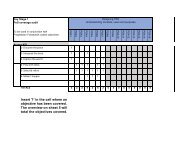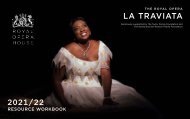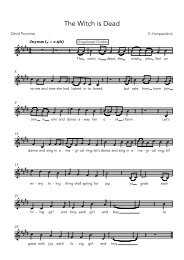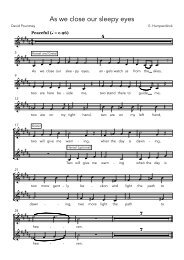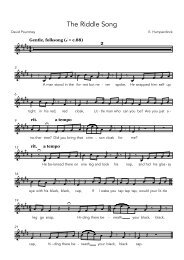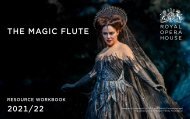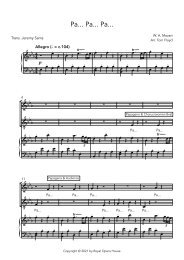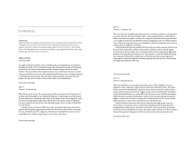You also want an ePaper? Increase the reach of your titles
YUMPU automatically turns print PDFs into web optimized ePapers that Google loves.
GISELLE<br />
RESOURCE WORKBOOK<br />
2021/22<br />
- Generously supported by The Taylor Family Foundation and<br />
The Gerald and Gail Ronson Family Foundation
YOUR VISIT<br />
We are really excited to welcome you and<br />
your students to the Royal Opera House for<br />
the Schools’ Matinee of <strong>Giselle</strong> on Friday 5<br />
November 2021.<br />
Film: Welcome to the Royal Opera House<br />
Click on the thumbnail below to view this film, which introduces<br />
you and your students to the Royal Opera House – guiding them<br />
through the spaces they will visit, introducing them to some of<br />
the people they will encounter and some of the exciting things<br />
they might see.<br />
Cover: Artists of The Royal Ballet in <strong>Giselle</strong> ©ROH/Bill Cooper, 2014<br />
Left: Alexander Campbell as Albrecht and Francesca Hayward as <strong>Giselle</strong> in <strong>Giselle</strong> ©2018<br />
ROH. Photograph by Helen Maybanks
THE STORY<br />
ACT I<br />
The village<br />
<strong>Giselle</strong> is a free spirit, much loved in her village in the forest. She has<br />
an innocent soul and loves life, but suffers from a weak heart. She has<br />
fallen in love with a young man called Loys, who has recently come to<br />
her village.<br />
Her mother Berthe wants <strong>Giselle</strong> to marry Hilarion, a forester from the<br />
village. She does not trust Loys, and warns <strong>Giselle</strong> by telling her the<br />
legend of the Wilis. Deep in the forest, she explains, the Wilis are ghosts<br />
of abandoned women who died before their wedding day and take<br />
revenge on men by forcing them to dance to their death.<br />
Berthe is right to be suspicious of Loys. Although she doesn’t know<br />
it, <strong>Giselle</strong> has actually fallen in love with Count Albrecht, who has<br />
disguised himself in order to get close to <strong>Giselle</strong>. In reality, he is<br />
engaged to Bathilde, the daughter of the Duke of Courland.<br />
A hunting party arrive at the village, including the Duke and Bathilde.<br />
Albrecht knows they will recognise him, so he hides. <strong>Giselle</strong> dances<br />
for the nobles and, when she tells Bathilde that she too is engaged,<br />
Bathilde gives her a necklace.<br />
When the hunting party leaves, Hilarion appears. He has broken into<br />
Albrecht’s cottage and found a sword which proves that Albrecht is a<br />
nobleman. Albrecht returns and Hilarion reveals his discovery to him.<br />
The hunting party returns and Bathilde claims Albrecht as her fiancé.<br />
The shock, heartbreak and betrayal is too much for <strong>Giselle</strong> and she loses<br />
her reason. Seizing Albrecht’s sword, she takes her own life.<br />
ACT II<br />
The forest<br />
<strong>Giselle</strong> has been buried deep in the forest, far away from the graves in<br />
the churchyard. Hilarion, heartbroken at <strong>Giselle</strong>’s death, watches by her<br />
grave. The ghostly Wilis arrive at midnight and Hilarion flees. Myrtha, the<br />
Queen of the Wilis, draws <strong>Giselle</strong> from her grave to make her join their<br />
group.<br />
Albrecht also searches the forest for <strong>Giselle</strong>’s grave to lay flowers on the<br />
earth where she is buried. <strong>Giselle</strong>’s spirit appears to Albrecht and leads<br />
him deep into the woods.<br />
The Wilis chase Hilarion through the woods and make him dance until,<br />
exhausted, he falls into a lake and dies. Next, they find Albrecht, and<br />
Myrtha commands him to dance to his death. <strong>Giselle</strong> tries to save<br />
Albrecht but he cannot resist Myrtha’s command to dance. <strong>Giselle</strong><br />
gives him strength by dancing with him, but as the night wears on he<br />
becomes weaker and weaker.<br />
Just as Albrecht is about to die, the sun rises. Daylight destroys the<br />
Wilis’ power and they fade away. <strong>Giselle</strong>, too, must return to her grave.<br />
Exhausted but alive, Albrecht realises that <strong>Giselle</strong>’s love and forgiveness<br />
have saved him. He fully realises how wrongly he treated <strong>Giselle</strong>. At the<br />
end of his strange and terrifying journey, Albrecht is alone at <strong>Giselle</strong>’s<br />
grave.
THE CHARACTERS<br />
GISELLE<br />
ALBRECHT<br />
HILARION<br />
BERTHE<br />
A young woman who lives with her<br />
‘Loys’ is not everything he seems: he is,<br />
A young man who lives in the village. He<br />
<strong>Giselle</strong>’s superstitious mother, who is<br />
mother, Berthe, in a small village deep in<br />
in fact, a young count called Albrecht. He<br />
does not trust Loys, and loves <strong>Giselle</strong>.<br />
suspicious of Loys. She worries about<br />
the forest. She loves to dance, but suffers<br />
has disguised himself in order to get to<br />
her sickly daughter, and would like her to<br />
from a weak heart. She has fallen in love<br />
know the beautiful <strong>Giselle</strong>.<br />
marry Hilarion.<br />
with Loys, a young man she believes to<br />
be a fellow villager.<br />
Akane Takada as <strong>Giselle</strong> in <strong>Giselle</strong> ©2016 ROH. Photograph by Tristram<br />
Kenton<br />
Vadim Muntagirov as Albrecht in <strong>Giselle</strong> ©2016 ROH. Photograph by<br />
Tristram Kenton<br />
Tomas Mock as Hilarion in <strong>Giselle</strong> ©2016 ROH. Photograph by Tristram<br />
Kenton<br />
Elisabeth McGorian as Berthe in <strong>Giselle</strong> ©2018 ROH. Photograph by<br />
Helen Maybanks
THE CHARACTERS<br />
BATHILDE<br />
The haughty daughter of the Duke of<br />
Courland, who she joins in a hunting<br />
expedition in the forest. She is engaged<br />
to be married to Albrecht.<br />
THE WILIS<br />
Beautiful, deadly ghosts of unmarried women who died after being mistreated by<br />
the men they loved. They take revenge on men who cross their paths in the forest<br />
by forcing them to dance themselves to death.<br />
MYRTHA<br />
The terrifying Queen of the Wilis, who<br />
discovers Hilarion and Albrecht in the<br />
forest.<br />
Christina Arestis as Bathilde in <strong>Giselle</strong> ©ROH/Tristram<br />
Kenton, 2011<br />
Artists of The Royal Ballet in <strong>Giselle</strong> ©ROH/Tristram<br />
Kenton, 2011<br />
Claire Calvert as Myrtha in <strong>Giselle</strong> ©2018 ROH. Photograph<br />
by Helen Maybanks
CONTENT WARNING<br />
Although <strong>Giselle</strong> is one of the most famous works in the ballet<br />
repertory, the story deals with some issues that you may want<br />
to explain and discuss with your students ahead of their visit.<br />
In Act I, we see that <strong>Giselle</strong> is happily in love with Loys.<br />
However, ‘Loys’ is actually Count Albrecht in disguise. He is a<br />
nobleman who has infiltrated the village community in order<br />
to take advantage of <strong>Giselle</strong>.<br />
Believing him to be genuine, <strong>Giselle</strong> has professed her love to<br />
Loys, but he has no intention of upholding his committment<br />
to her. He is already betrothed to Bathilde, daughter of the<br />
Duke of Courland, who passes through the village with a noble<br />
hunting party.<br />
<strong>Giselle</strong> discovers who Albrecht really is in a very public way<br />
– in front of the rest of her village community, and also the<br />
visiting nobles. The humiliation, shame and distress cause her<br />
to lose her reason and take her own life with Albrecht’s sword.<br />
Act II features the ghostly Wilis, but <strong>Giselle</strong>’s love and<br />
forgiveness allow her to save Albrecht’s life and return to her<br />
grave to rest in peace.<br />
The story juxtaposes love and betrayal, life and death,<br />
vengeance and forgiveness. This production of <strong>Giselle</strong> has<br />
moments of tension and violence, although this is inferred<br />
through dance.<br />
Federico Bonelli as Albrecht and Lauren Cuthbertson as <strong>Giselle</strong> in<br />
<strong>Giselle</strong> ©2016 ROH. Photograph by Tristram Kenton
MIME IN GISELLE<br />
In ballet, we tell stories and express emotions through<br />
movement and without words. In <strong>Giselle</strong>, this is done in two<br />
ways: through dance and through mime.<br />
Act I in particular is made up of short mimed scenes<br />
interspersed with episodes of dancing. The character of<br />
Berthe (<strong>Giselle</strong>’s mother) expresses much of the story through<br />
mime. This is like a kind of sign language. We’ve provided a<br />
gallery of images of a section of mime where Berthe tells the<br />
story of the Wilis, their Queen, Myrtha, and what they do to<br />
men who come across them in the forest. See if you and your<br />
students can understand from the images how she expresses<br />
the following text through mime:<br />
In the dark forest, beneath the leaning trees, there is a grave.<br />
Here spirits rise from the ground – Wilis! – and, leading them,<br />
their Queen.<br />
What’s that? A man strolling in the forest. A noble gentleman.<br />
He is stopped in his tracks by the Queen of the Wilis.<br />
‘You,’ says the Queen to the gentleman, ‘shall dance and die<br />
here.’<br />
‘Have mercy, please’, begs the gentleman, offering his pleas<br />
to the Wilis gathered there. But as he dances he tires, he<br />
becomes exhausted. His heart begins to fail him and he dies.<br />
Kristen McNally illustrating the mime performed by <strong>Giselle</strong>’s mother Berthe<br />
in <strong>Giselle</strong> Act I ©ROH/Andrej Uspenski, 2013
THE COMPOSER<br />
ADOLPHE ADAM (1803–56)<br />
Adolphe Adam was a French composer,<br />
mostly of ballets and operas. <strong>Giselle</strong> is<br />
the best known and most performed of<br />
his stage works today.<br />
Adam’s father was also a musician<br />
– a pianist and teacher – but he was<br />
strongly against the idea of his son<br />
pursuing a career in music. So when<br />
he began to compose and play music,<br />
he did so secretly, and was only<br />
allowed to study formally at the Paris<br />
Conservatoire under the promise that<br />
he would not pursue a career in music.<br />
During his study, he specialized in<br />
playing the organ, the harmonium (a<br />
small reed organ which is powered<br />
by bellows) and timpani (large, tuned<br />
drums that are a crucial part of the<br />
sound of the orchestra).<br />
He made a living mostly by playing the<br />
organ, teaching composition at the<br />
conservatoire at which he had studied,<br />
and putting on his ballets and operas.<br />
In 1847 he opened his own opera house,<br />
although it was closed a year later due<br />
to the French ‘February Revolution’ of<br />
1848.<br />
You may have already heard Adam’s<br />
music without realising it, in the<br />
Christmas carol ‘O Holy Night’.<br />
TIMELINE<br />
1803 Born in Paris, France<br />
1820 Learns organ, counterpoint and<br />
composition<br />
1829-32 Moves to London, composes<br />
works for the Theatre Royal, Covent<br />
Garden (on the site of what is now the<br />
Royal Opera House)<br />
1841 Composes music for the ballet<br />
<strong>Giselle</strong><br />
1848 Loses all his money in a<br />
disasterous bid to open a new theatre<br />
1856 Dies in Paris
POST-PERFORMANCE ACTIVITIES<br />
ACTIVITY 1 - MAKE YOUR OWN HAUNTED FOREST<br />
Act II of <strong>Giselle</strong> takes place in the forest. It is night time, and both<br />
Albrecht and Hilarion have come to the forest to look for <strong>Giselle</strong>’s<br />
grave. The Wilis – ghosts of women abandoned before their<br />
wedding day – arrive under the moonlight at midnight.<br />
In this activity, your students are going to make a tiny haunted<br />
forest in a little box. Ask them to imagine that the frame of the<br />
box is a bit like the proscenium arch of the Royal Opera House.<br />
What kind of enchanted forest will be hiding inside waiting to be<br />
discovered? Will it be glittery and magical? Or will it be dark and<br />
scary?<br />
TIME GUIDELINE<br />
45 minutes<br />
YOU WILL NEED<br />
• A small box. It could be a match box, cosmetics packaging or<br />
an unwanted jewellery box. The smaller the better!<br />
• Paper<br />
• Coloured pens<br />
• Glue stick<br />
Artists of The Royal Ballet in <strong>Giselle</strong> ©ROH/Bill Cooper, 2014
ACTIVITY 1 - MAKE YOUR OWN HAUNTED FOREST<br />
INSTRUCTIONS:<br />
Step One<br />
First, decorate the inside of the box with coloured pencils or pens.<br />
Try to make the bottom or back of the box appear as if the forest is<br />
continuing into the distance.<br />
Step Two<br />
Make three-dimensional layers that you will add into the box. These<br />
could be trees, flowers or long grass.<br />
Cut these out of paper and leave a tiny tab at the bottom to stick<br />
them into the box. Colour them in before sticking them down.<br />
It should end up looking like a pop-up picture <strong>book</strong>. You could<br />
even gather tiny pieces of twig or leaves from outside to add to<br />
your forest!<br />
Step Three<br />
Now add tiny magical creatures or ghostly figures to your forest.<br />
These could be made of tiny scraps and paper and could be hidden<br />
among the trees.<br />
Step Four<br />
Make sure you decorate the inside of the lid of your box as well. If<br />
the lid is attached to the box, the design could also be attached to<br />
it.<br />
Step Five<br />
When your students have finished decorating their box, ask them<br />
to invite someone to open it and explore the magical haunted<br />
forest inside.<br />
Marianela Nuñez as <strong>Giselle</strong> and Vadim Muntagirov as Albrecht in <strong>Giselle</strong> ©2016 ROH.<br />
Photograph by Tristram Kenton
ACTIVITY 1 - MAKE YOUR OWN HAUNTED FOREST<br />
IDEAS TO EXTEND THIS ACTIVITY<br />
Your students can try working together to make a bigger version<br />
of the haunted forest scene by using larger boxes, like a shoe<br />
box or a bigger cardboard box.<br />
They could also experiment with the kinds of materials they<br />
use to create their haunted forest scene. Tissue paper, fabric<br />
or recycled plastic cut out and painted to look like foliage – the<br />
opportunities are endless. Encourage your students to use their<br />
imagination to decorate their boxes!<br />
Ask the students to consider other ways to add atmosphere to<br />
their enchanted forest scenes. How could they play with lighting<br />
to create dramatic effects? For example, they could cut holes in<br />
the top part of their box, cover over with coloured tissue paper<br />
and hold the box under a light source. This will create magical<br />
coloured lighting effects.<br />
Artists of The Royal Ballet in <strong>Giselle</strong> ©2016 ROH. Photograph by<br />
Tristram Kenton
ACTIVITY 2 - DRAW THE INSIDE OF GISELLE AND ALBRECHT’S COTTAGES<br />
Act I of <strong>Giselle</strong> takes place outside, in the village in which <strong>Giselle</strong><br />
lives. The action takes place in this space; it is here that <strong>Giselle</strong><br />
and Albrecht meet, and also where the villagers gather to dance<br />
and celebrate the arrival of the noble hunting party.<br />
You will see in our production that there are two cottages<br />
that feature on either side of the stage. One belongs to <strong>Giselle</strong><br />
and her mother, Berthe. The other belongs to Albrecht, who is<br />
pretending to be a fellow villager called Loys.<br />
In this activity, your students will choose one of the cottages<br />
and draw the inside as they imagine it. Ask them to consider<br />
how <strong>Giselle</strong> and her mother, Berthe, live? What kind of furniture<br />
do they think they would have? How about Albrecht? Would his<br />
cottage be neat or messy? Remember that Albrecht secretly<br />
hides his nobleman’s sword in his cottage. What other items that<br />
feature in the story do you think these characters would keep<br />
inside their homes?<br />
Vadim Muntagirov as Albrecht in <strong>Giselle</strong> ©2016 ROH. Photograph by Tristram Kenton
ACTIVITY 2 - DRAW THE INSIDE OF GISELLE AND ALBRECHT’S COTTAGES<br />
TIME GUIDELINE<br />
30+ minutes<br />
YOU WILL NEED<br />
• Paper<br />
• Pencil<br />
• Colour pencils, pens or paint<br />
• Any other decorations as necessary<br />
IDEAS TO EXTEND THIS ACTIVITY<br />
Ask your students to think about their own homes, either real or<br />
imagined. They could:<br />
• Describe them to each other using lots of descriptive<br />
words<br />
• Write a story set entirely indoors<br />
Marianela Nuñez as <strong>Giselle</strong> and Vadim Muntagirov as Albrecht in <strong>Giselle</strong> ©2016 ROH.<br />
Photograph by Tristram Kenton
NATIONAL PROGRAMMES<br />
We place creative learning at the centre of children’s education,<br />
through certified CPD and online programmes, opening a<br />
window into the world of ballet, opera and theatrecraft.<br />
Our <strong>resource</strong>s, created together with teachers in schools across<br />
the UK:<br />
• Build teachers’ confidence, providing the tools to facilitate<br />
learning through the arts. No previous experience required.<br />
• Develop students’ creativity, resilience, communication and<br />
and other transferable skills.<br />
• Are relevant to current school topics, providing a theme for<br />
cross-curricular work and a springboard for literacy.<br />
WE OFFER:<br />
• Practical training for KS1 to KS5 teachers country-wide.<br />
• Free <strong>digital</strong> <strong>resource</strong>s offering two-lesson (Taster), five-lesson<br />
(Explorer) and ten-lesson (Immersive) schemes of work.<br />
• Introductory films that inspire and entertain students,<br />
reinforcing the activities and concepts they encounter in the<br />
lessons.<br />
• Programmes schools can use to suppor their ArtsMark<br />
journey. Arts Award Explore or Discover <strong>resource</strong>s also available.
FURTHER PROGRAMMES<br />
CREATE & DANCE<br />
createanddance@roh.org.uk<br />
KS1 to KS3<br />
This programme provides an understanding of dance<br />
by unlocking children’s imaginations and creativity.<br />
CREATE & SING<br />
createandsing@roh.org.uk<br />
KS1 to KS3<br />
This programme develops skills in singing, drama,<br />
storytelling, characterization and music.<br />
CREATE & DESIGN<br />
createanddesign@roh.org.uk<br />
KS1 to KS3<br />
Develop an understanding of stage design and follow<br />
a brief to design sets for a ballet.<br />
CREATE & LEARN<br />
For more information on all of our programmes<br />
visit: learning-platorm.roh.org.uk





